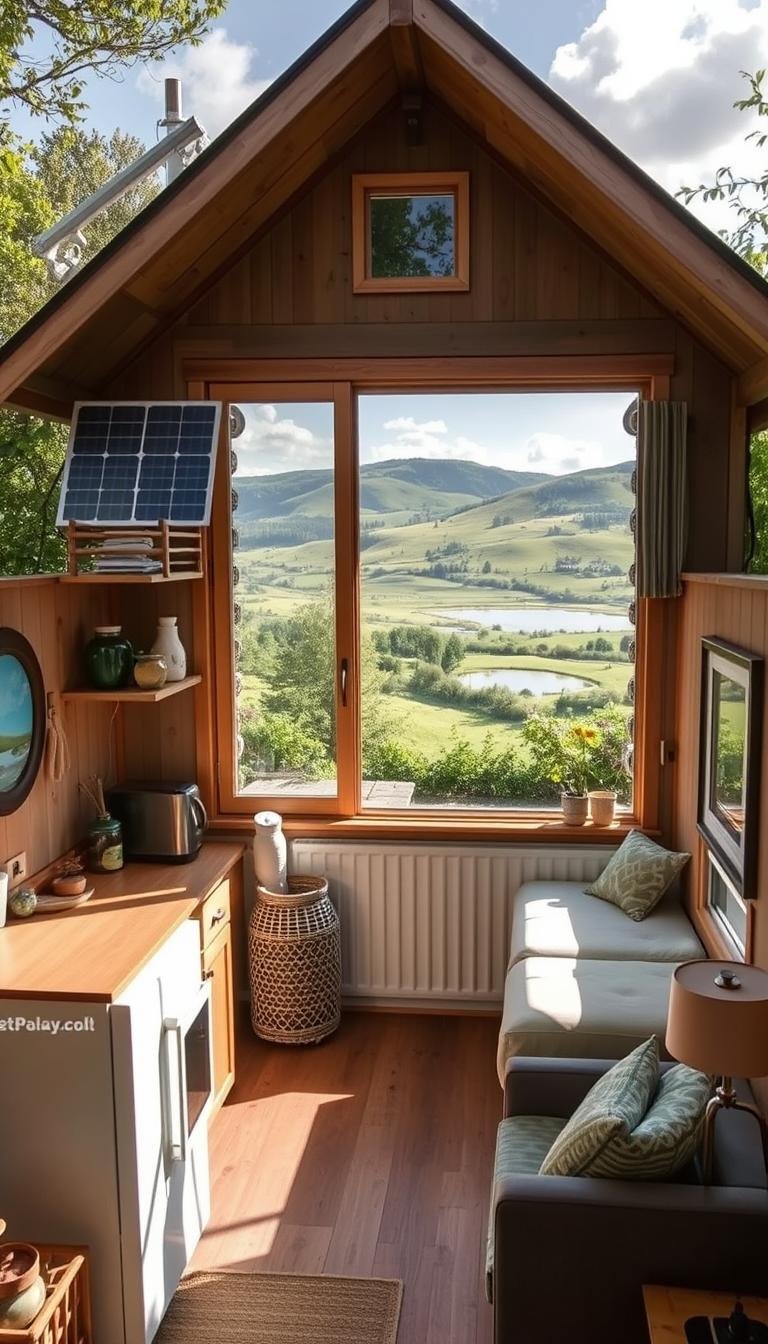Living in a smaller home doesn’t mean sacrificing comfort or style. In fact, it opens doors to creative solutions that benefit both residents and the planet. Every choice—from energy use to daily habits—adds up, creating ripple effects that extend far beyond four walls.
U.S. households contribute significantly to global emissions through resource consumption. But imagine if every home prioritized efficiency. Tiny spaces naturally encourage mindful consumption, making it easier to reduce waste and conserve water, electricity, and materials.
This approach to compact living isn’t just about downsizing. It’s about maximizing every square foot to support ecological balance. Simple upgrades like solar panels or rainwater collection systems turn limited space into a powerhouse for sustainability. These efforts, when multiplied across communities, create measurable environmental progress.
Key Takeaways
- Small living spaces naturally promote resource conservation
- Energy-efficient upgrades amplify eco-friendly benefits
- Individual actions collectively reduce greenhouse gas emissions
- Tiny homes encourage intentional consumption habits
- Sustainable choices in compact spaces support broader environmental goals
Tiny House Living and Sustainable Design Foundations
Building a sustainable tiny home starts with intentional design choices. Every material and layout decision impacts long-term efficiency. Smart planning transforms limited square footage into functional, earth-friendly living spaces.
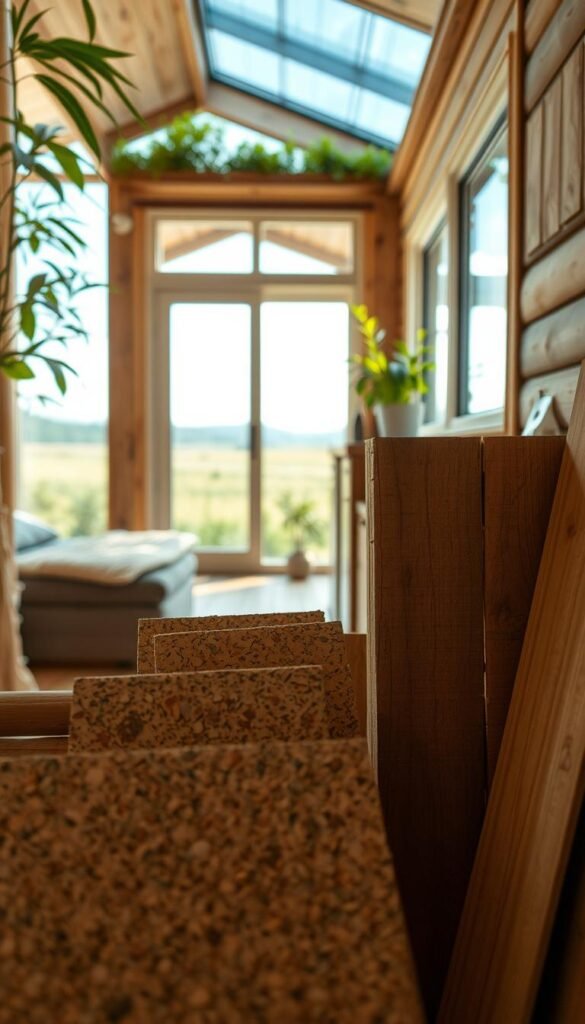
Adopting Eco-Friendly Materials
Reclaimed wood and recycled steel reduce deforestation and manufacturing waste. These materials often outlast conventional options, needing fewer replacements. Low-VOC paints and plant-based insulation improve indoor air quality while minimizing chemical runoff.
Durability matters in compact houses. High-performance windows and metal roofing withstand weather extremes. This lowers maintenance costs and keeps materials out of landfills for decades.
Smart Space Utilization for Efficiency
Multi-functional furniture like fold-down tables maximizes every inch. Built-in shelves replace bulky storage units, freeing floor space. Vertical designs use wall areas often ignored in traditional homes.
Thoughtful layouts reduce energy needs. Strategic window placement harnesses natural light, cutting electricity use. Compact appliances conserve water and power without sacrificing modern convenience.
Incorporating Green Practices into Tiny-House Living
Adopting earth-conscious habits transforms compact living spaces into eco-friendly havens. Small changes in daily routines yield measurable results, cutting household waste while saving money over time. Focus on reusable items that replace disposables – this strategy works wonders in limited square footage.

Practical Eco-Friendly Steps for Daily Life
Swap paper towels for washable cloths and plastic wrap for silicone lids. These products last years, reducing trash by up to 40% in some homes. Keep a dedicated recycling bin to simplify proper waste sorting – crucial in spaces without room for multiple containers.
Try these easy ways to go greener:
- Use bamboo toothbrushes instead of plastic ones
- Choose bar soap over liquid bottles
- Opt for rechargeable batteries
Easy Upgrades for a Greener Home
Install LED bulbs – they use 75% less energy than traditional options. Add aerators to faucets for immediate water savings. These tips require minimal effort but create lasting change.
Consider secondhand furniture or upcycled items when decorating. Thrift stores often have quality products that prevent manufacturing emissions. Every reused object keeps materials out of landfills and reduces demand for new resources.
Energy Efficiency and Renewable Energy Options for Tiny Homes
Powering compact spaces requires smart solutions that balance needs with environmental responsibility. Tiny homes excel at minimizing energy demands while maximizing renewable potential through clever design.
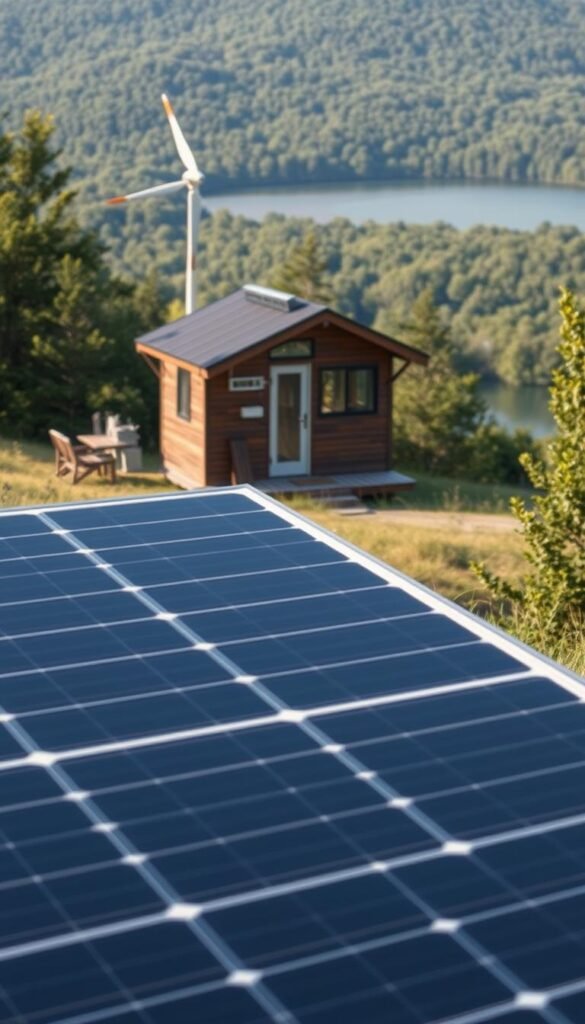
Solar and Alternative Energy Solutions
Rooftop solar panels can fully power most small dwellings when paired with lithium batteries. These systems store excess energy for nighttime use or cloudy days. For windier locations, micro-turbines supplement solar arrays effectively.
Off-grid setups often combine multiple renewable energy sources. Portable solar generators provide backup during seasonal changes. This hybrid approach ensures consistent power without fossil fuels.
Maximizing Home Energy Efficiency
Triple-pane windows prevent 70% more heat transfer than standard models. Proper insulation in walls and roofs maintains comfortable temperatures year-round. These upgrades slash heating and cooling costs dramatically.
Energy-efficient appliances make a big difference in compact spaces. Look for ENERGY STAR® rated refrigerators and induction cooktops. They use 30-50% less power than conventional models while performing better.
Smart thermostats optimize climate control by learning daily routines. Programmable outlets automatically shut off vampire energy drains from idle devices. Together, these tools create an ultra-efficient house that wastes nothing.
Water Conservation and Waste Reduction in Tiny Spaces
Tiny homes offer unique opportunities to revolutionize water use and waste handling. Limited space demands creative solutions that protect resources while maintaining modern convenience. Strategic upgrades and daily habits work together to minimize environmental impact.
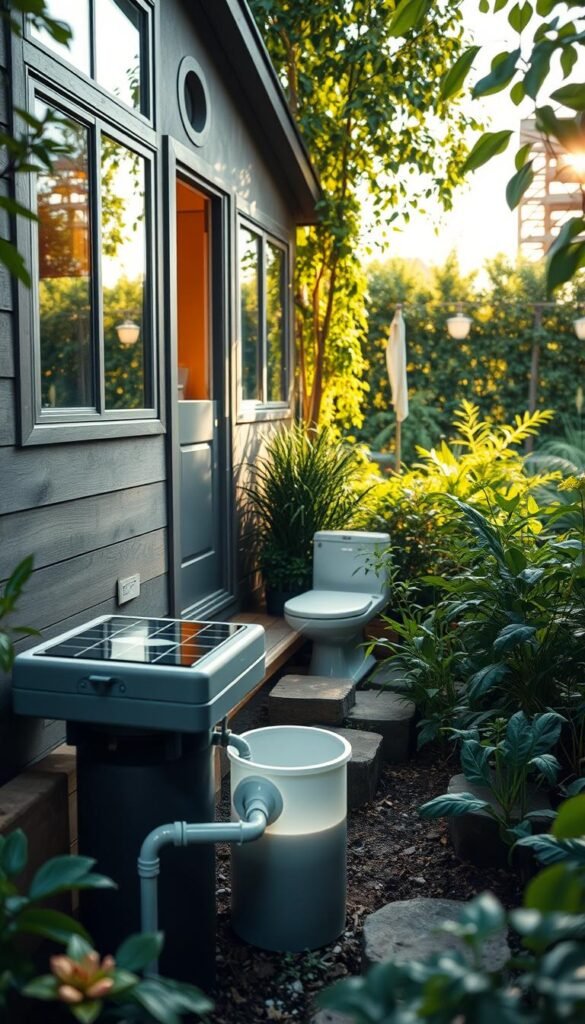
Smart Fixtures and Rainwater Solutions
Low-flow showerheads cut water use by 40% without sacrificing pressure. Dual-flush toilets save 20% more water per flush compared to standard models. These fixtures reduce utility bills while conserving thousands of gallons annually.
Rain barrels connected to gutter systems capture free water for gardens or cleaning. A single storm can collect enough to flush toilets for weeks. This approach reduces reliance on treated municipal supplies.
Three proven strategies for tiny homes:
- Install aerators on all faucets
- Use composting toilets to eliminate blackwater waste
- Route greywater to irrigate edible plants
Proper waste sorting becomes critical in compact layouts. Designate bins for recycling and food scraps near high-use areas. This prevents pollution from improper disposal and simplifies routines.
Closed-loop systems turn challenges into advantages. One homeowner reported cutting water use by 60% after adding a filtration system for reused shower water. These innovations prove small spaces can drive big environmental change.
Eco-Friendly Building Materials and Green Upgrades
Constructing an earth-conscious house starts with material choices that protect both residents and the environment. Modern builders now access innovative products combining durability with low ecological impact. These solutions reduce long-term costs while creating healthier living spaces.
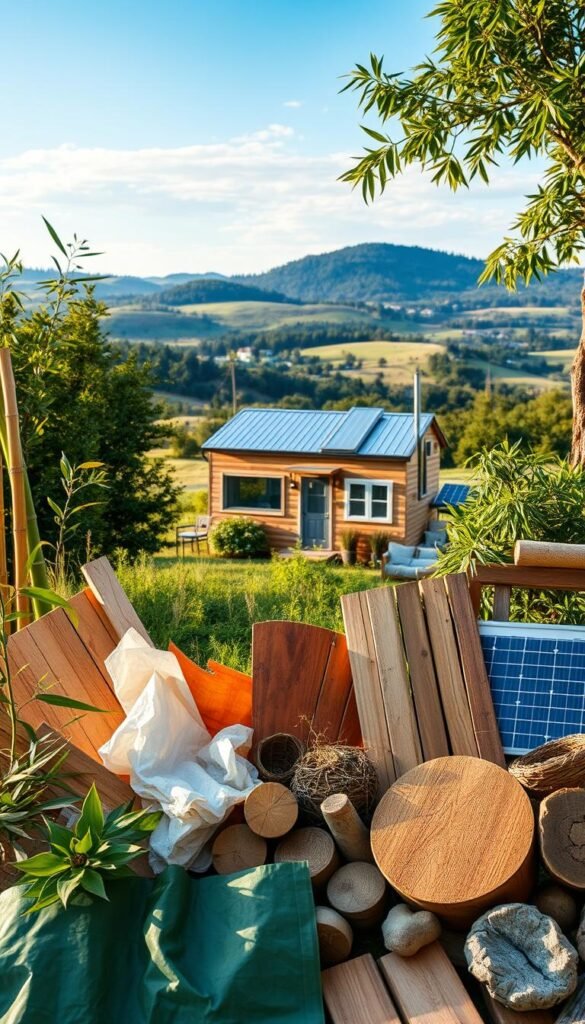
Innovative Sustainable Materials and Finishes
Recycled composite decking outlasts traditional wood by 10+ years. Made from plastic bags and sawdust, it resists rot and insects. Reclaimed barn wood adds character while preventing deforestation – a popular choice for accent walls.
| Material | Key Benefits | Best Use | Cost Per Sq Ft |
|---|---|---|---|
| Straw Bale | Superior insulation | Wall systems | $1.50-$3 |
| Cool Roofing | 70% heat reflection | Hot climates | $2.80-$5 |
| Low-VOC Paint | Cleaner indoor air | All surfaces | $35-$60/gal |
| Bamboo Flooring | Rapidly renewable | High-traffic areas | $4-$8 |
Non-toxic finishes like milk paint eliminate harmful fumes. Natural linoleum floors made from jute and linseed oil withstand heavy use. These materials often perform better than conventional options.
Three key factors when selecting products:
- Manufacturing energy requirements
- Recyclability at end-of-life
- Local availability to reduce transport emissions
Metal roofing reflects sunlight while lasting 50+ years. Combined with proper insulation, it cuts cooling costs by 25% in warm regions. These upgrades make any home more efficient without sacrificing style.
DIY Green Cleaning and Maintenance for Tiny Homes
Keeping compact spaces spotless while protecting the environment starts with simple ingredient swaps. Conventional cleaning products often contain ammonia and synthetic chemicals that pollute waterways and indoor air. Natural alternatives prove equally effective without the ecological toll.
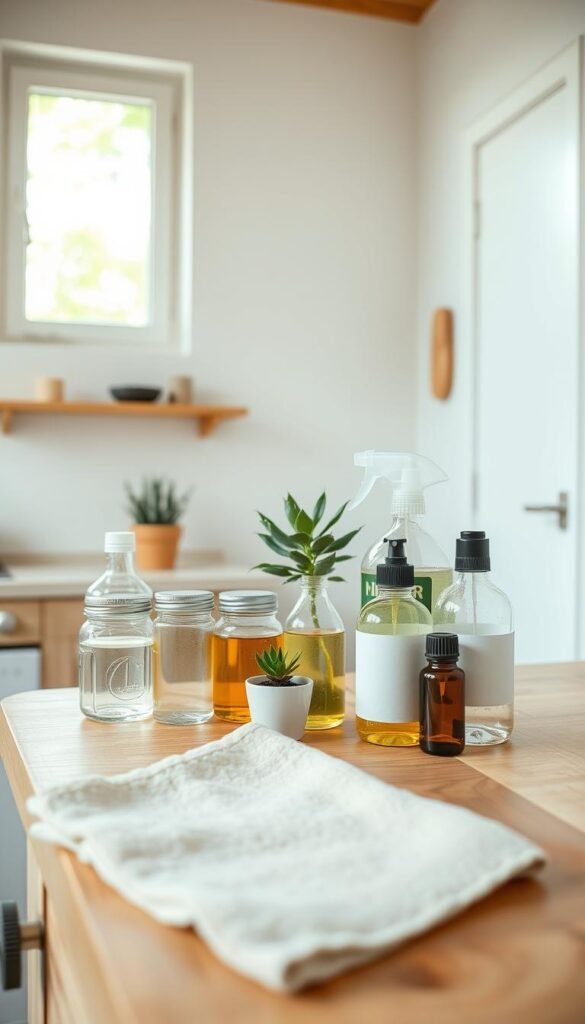
Natural Cleaning Recipes and Low-Waste Products
Citrus vinegar cleaner tackles grease and odors in minutes. Combine white vinegar with orange peels in a glass jar for two weeks – strain and mix with water. Baking soda paste scrubs surfaces without scratching.
Three essential DIY products for tiny homes:
- All-purpose spray: 1 cup water, ¼ cup castile soap, 10 drops tea tree oil
- Glass cleaner: 2 cups water, ½ cup rubbing alcohol, 1 tbsp cornstarch
- Floor wash: 1 gallon hot water, ½ cup borax, 20 drops lemon oil
Maintenance Tips to Reduce Toxic Chemicals
Microfiber cloths replace disposable wipes for 500+ uses. They capture dust better than paper towels when dampened with water. Store homemade solutions in labeled spray bottles to save time and counter space.
Swap these common toxins:
| Conventional Product | Natural Alternative | Cost Savings |
|---|---|---|
| Bleach | Hydrogen peroxide | 40% |
| Drain cleaner | Baking soda + vinegar | 75% |
| Furniture polish | Olive oil + lemon juice | 90% |
Regular maintenance prevents mold without harsh fungicides. Open windows during cleaning to circulate fresh air. These tips create healthier living spaces while cutting plastic waste from store-bought products.
Sustainable Landscaping and Outdoor Upgrades
Transforming outdoor areas into eco-friendly extensions of compact homes creates harmony between living spaces and nature. Thoughtful design turns every square foot into functional, planet-friendly zones that thrive with minimal upkeep.
Rain Gardens and Edible Landscapes
Rain gardens filter stormwater naturally using native plants like switchgrass and black-eyed Susans. These shallow depressions reduce runoff while attracting pollinators. Pair them with edible shrubs like blueberries for dual-purpose beauty and snacks.
Drip irrigation systems deliver water straight to roots without pumps. This cuts electricity use and evaporation by 60% compared to sprinklers. Mulch retains moisture, reducing watering needs by half during hot months.
Three steps to start:
- Choose drought-resistant plants suited to your climate
- Layer compost to enrich soil naturally
- Install rain barrels under gutter downspouts
Upgraded Roofing and Smart Storage Solutions
Living roofs with sedum plants insulate homes while absorbing rainwater. Pair them with solar panels for energy production that complements landscape goals. Metal roofing channels precipitation into storage tanks for garden use.
Vertical storage units keep tools organized without cluttering patios. Foldable furniture like stackable chairs maximizes entertaining areas. These space-saving solutions adapt to seasonal needs while reducing material waste.
Key benefits of upgraded roofing:
- 25% lower cooling costs with reflective surfaces
- Extended roof lifespan (50+ years)
- Harvested rainwater for irrigation
Community and Lifestyle: Embracing Sustainability
True sustainability extends beyond walls and rooftops into shared spaces and daily interactions. Neighborhood networks amplify eco-friendly efforts, turning individual actions into collective impact. This approach strengthens regional economies while nurturing meaningful connections.
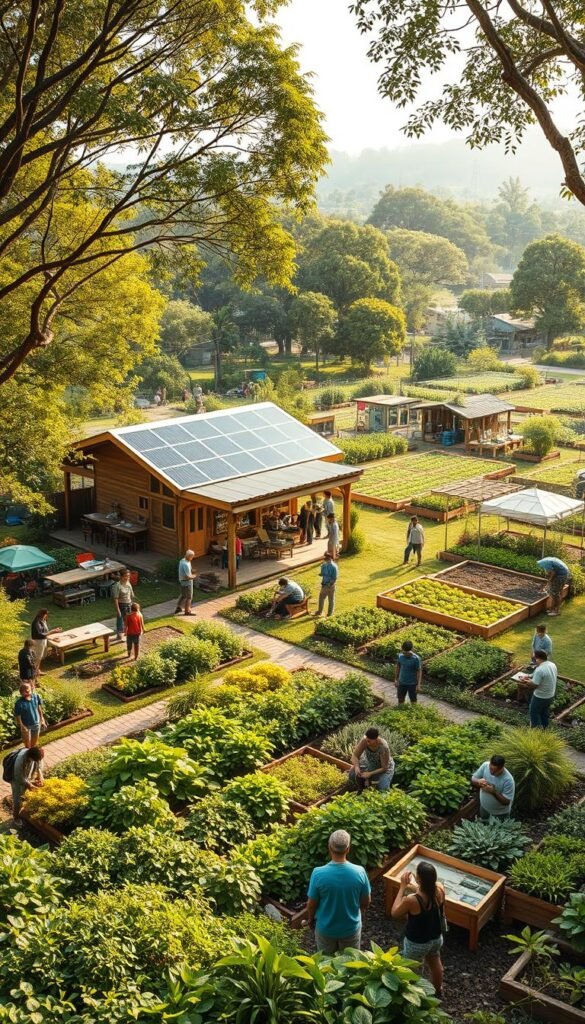
Strengthening Local Economies
Choosing neighborhood stores over chains slashes transportation emissions dramatically. Local shops source 68% of goods within 50 miles, cutting packaging waste by 40% compared to national retailers. These choices keep dollars circulating locally, funding parks and schools.
Five ways to back small businesses:
- Join community-supported agriculture (CSA) programs
- Borrow tools from neighborhood lending libraries
- Attend craft fairs featuring regional artisans
- Share positive online reviews
- Split bulk orders with neighbors
| Benefit | Local Businesses | Chain Stores | Environmental Impact |
|---|---|---|---|
| Transport Miles | 15-50 | 500+ | Reduces carbon footprint by 75% |
| Packaging | Minimal/reusable | Plastic-heavy | Cuts landfill waste by 30% |
| Job Creation | 1 per $63K revenue | 1 per $210K revenue | Strengthens community resilience |
Farmers markets create hubs for exchanging fresh produce and sustainability tips. Many now host repair workshops and composting demos. These events build practical skills while reducing household waste.
Neighborhood tool shares prevent duplicate purchases of rarely-used items. One drill can serve 20 homes, avoiding 19 manufacturing processes. Such collaborations make eco-living affordable and social.
Regional food systems shrink carbon footprints through shorter supply chains. Meal planning around seasonal harvests cuts refrigeration needs. These habits support sustainability while introducing diverse flavors.
Conclusion
Every sustainable choice in compact homes creates waves of positive change. From solar-powered energy systems to water-saving fixtures, these ways of living prove small spaces deliver big environmental results. Over years, such decisions add up – lowering utility bills while protecting natural resources.
Tiny homes showcase how smart design meets ecological responsibility. Durable materials and energy-efficient upgrades work together seamlessly. This approach reduces waste without sacrificing modern comforts, proving sustainability and practicality coexist.
These ideas extend beyond individual living spaces. When neighbors adopt similar practices, entire communities shrink their carbon footprint. Shared gardens, tool exchanges, and local products amplify the impact further.
Start with one change – switch to LED bulbs or install a compost system. Each step toward eco-conscious home management helps safeguard our environment. Together, these efforts build healthier futures while redefining what modern living can achieve.

